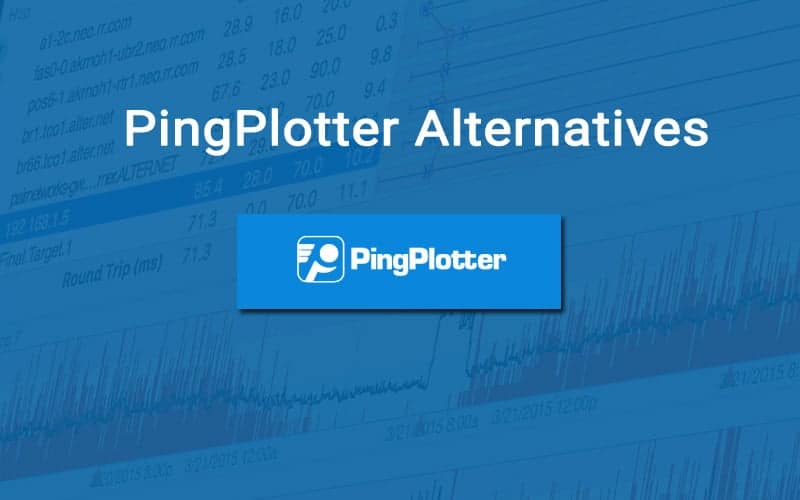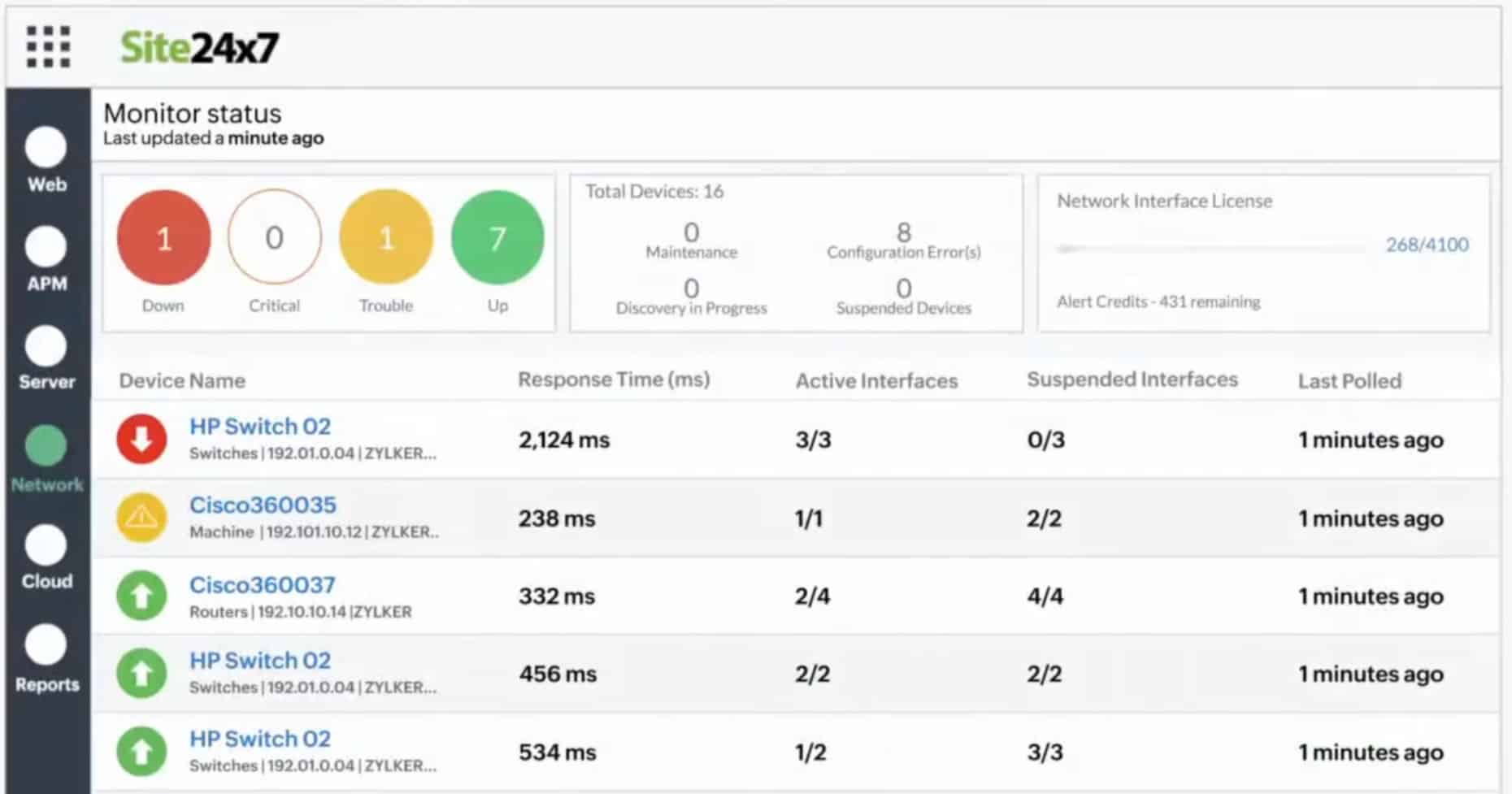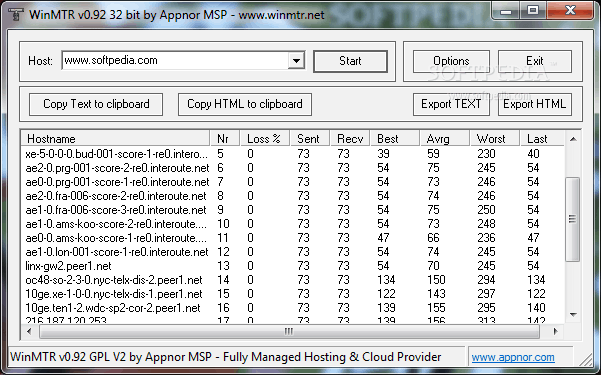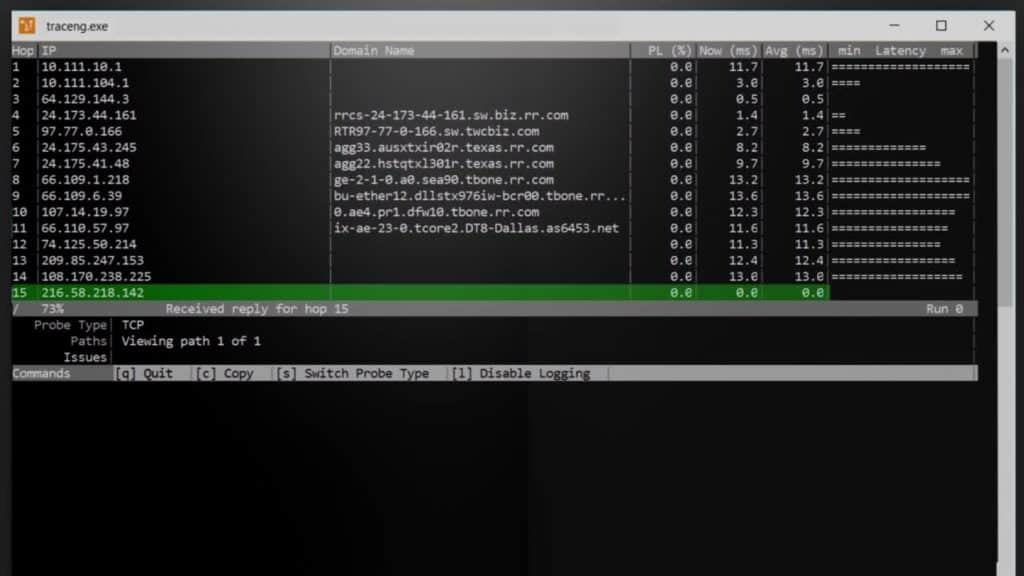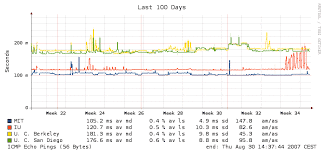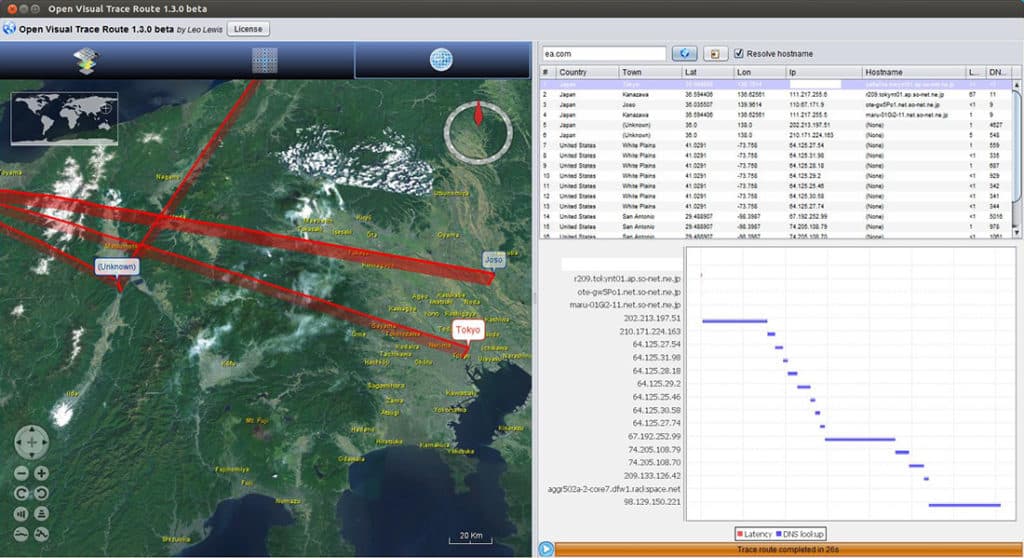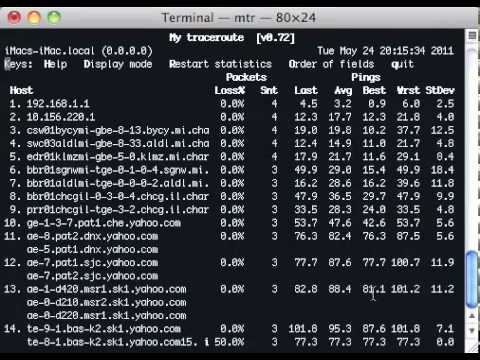PingPlotter is a powerful monitoring and diagnostic tool for your network. This tool runs in the background collecting information about your network, and presents the same in an intuitive graphical format when you need it. This information can be particularly useful for identifying and fixing problems in your network. Though it is a useful tool, it comes with some shortcomings, especially when compared to other PingPlotter alternatives available in the market.
Here is our list of the best PingPlotter alternatives:
- Site24x7 Network Monitoring Tool – EDITOR’S CHOICE Robust, integrated cloud monitoring tool offering comprehensive features with strong visibility into network performance. Download a 30-day free trial.
- ManageEngine OpManager – FREE TRIAL A comprehensive network monitoring tool that offers deep insights into the metrics required for network diagnostics, troubleshooting, and bandwidth connectivity lags. Download a 30-day free trial.
- TraceRoute NG – FREE TOOL A standout SolarWinds product for fast, accurate network path analysis with advanced NetPath technology.
- WinMTR – A diagnostic tool that expertly combines traceroute and ping functionalities, ideal for network path analysis and monitoring.
- SmokePing – Specializes in network latency tracking with interactive graph explorers and a wide range of latency measurement plugins.
- Open Visual Traceroute Offers – Innovative 3D and 2D map visualizations for network path analysis, supporting multiple operating systems.
- MTR – Combines traceroute and ping features, providing real-time statistics and performance reports for comprehensive network analysis.
Some of the prominent shortcomings of PingPlotter are:
- Many other tools are graphically more impressive than PingPlotter
- Doesn’t have a map interface
- Communication uses TCP port 9636 only
Due to these drawbacks, PingPlotter may not always be the best option. But the good news is that there are other software that could do the job for you in a better way.
The Best PingPlotter Alternatives
Methodology for selecting the best PingPlotter alternative tools
In order to evaluate network performance, PingPlotter collects data about your network’s performance and displays it in a graphical format. No doubt, it is one of the most popular network monitoring tools but has certain limitations. Outdated graphics, no map interface, and limited features are a few drawbacks which could lead organizations to look for its alternatives. When selecting PingPlotter alternatives, make sure you follow our shared methodology:
- All the features supported by PingPlotter or more
- Better port than PingPlotter
- User-friendly interface with illustrative graphics that display real-time results
- Scans the entire network
- Integration with other tools
- Free trial or assessment period available
Let’s take a look at each of these tools in depth and have a look at their interfaces as well below.
1. Site24x7 Network Monitoring Tool – FREE TRIAL
Site24x7 Network Monitoring Tool is an integrated cloud monitoring tool that provides granular visibility into each device and helps organizations track the performance of their networks. It further aids businesses in detecting anomalies, auto-discovering devices, monitoring memory and CPU usage, VPN latency, and other key metrics.
Key Features:
- Monitors networks from a single console
- Auto-discovery and network topology
- Custom dashboards offering granular visibility into key metrics
- Provides out-of-the-box reports
- Supports third-party integrations
- Works well on Android and iOS apps
- Threshold limit configurations
Why do we recommend it?
Site24x7 is a robust tool that offers complete control and comprehensive features that help track packets, errors, and in-and-out network traffic. Additionally, you can use the tool to discover network topology and devices connected to it.
Network administrators can even set threshold limits for all the key performance metrics at the interface as well as device level using the tool. Thus, allowing watching over the performance of the networks and taking appropriate action in the event of a breach. It is easy to use and supports 50+ plugin integrations that play a good role in enhancing its monitoring capabilities. Site24x7 also offers round-the-clock professional customer support.
Who is it recommended for?
Network administrators or any business that is willing to track their network performance and reduce downtime can invest in Site24x7. However, in comparison to other competitors, the cost seems a bit high.
Pros:
- Track in-and-out traffic, NCM, and overall network performance from a single console
- Full-stack monitoring tool featuring over 60 performance indicators
- Administrators can receive instant alerts and notifications via SMS messages, emails, push notifications, or RSS feeds
- Integrates well with Jira, Slack, and other third-party tools
Cons:
- Overwhelming and challenging for some users to add their own unique plugins
You can register for access to a 30-day free trial.
EDITOR'S CHOICE
Site24x7 Network Monitoring Tool is our top pick for a PingPlotter alternative for network diagnostic and troubleshooting bandwidth, connectivity, and lag. This is because the system provides a discovery service that identifies all devices connected to the network, and then documents them in an inventory. The package also automatically draws up a network topology map. This system implements continuous network scanning, identifying changes and, updating documentation accordingly. The package additionally provides connection testing tools, such as Ping and Traceroute to check on the availability of devices and the conditions of connections. The Site24x7 platform includes a Synthetic Monitoring service. This is specifically designed to check on the availability and performance of off-site, web-based systems. So, the Site24x7 package includes Ping-based troubleshooting tools that cover a private network and an extended network of services across the internet.
Download: Get a 30-day FREE Trial
Official Site: https://www.site24x7.com/signup.html?pack=44&l=en&lp=1
OS: Cloud-based
2. ManageEngine OpManager – FREE TRIAL
ManageEngine OpManager is a comprehensive network monitoring tool that also encompasses information about the availability and performance of your network. It monitors metrics like jitter, latency, and packet loss to help you understand and resolve the problems in your network.
Key Features:
- Continuous monitoring of metrics
- Adaptive thresholds that improve the relevance of metrics
- Extensive visualization and reporting tools
- Integrated troubleshooting capabilities
Why do we recommend it?
OpManager is a good alternative to PingPlotter as it offers the same levels of visualizations and insights. However, it is way more than a PingPlotter as it can monitor other aspects of your network to provide better context for troubleshooting. Also, it can be extended to cover other areas as well. Its many advanced features, like adaptive thresholds and root cause analysis, enable you to take a proactive approach to troubleshooting.
Who is it recommended for?
It is recommended for enterprises of all sizes and SMBs who want to use metrics to proactively identify and fix issues in networks.
Pros:
- Takes a proactive approach to network monitoring and resolution
- Excellent documentation and customer support
- Highly scalable
- Flexible configuration options
Cons:
- Initial setup requires technical expertise
OpManager has two editions. The Standard edition starts at $95, while the Professional edition starts at $145. Download a 30-day free trial.
3. WinMTR
WinMTR is a diagnostic tool that combines the functions of a traceroute and ping program into the same software. MTR stands for My Traceroute, though it was originally named Matt’s Traceroute to honor Matt Kimball, the person who originally wrote this program. In fact, this program is a Windows alternate to Matt’s traceroute that was available only on Unix/Linux.
Key Features:
- Based on ICMPO Time Exceeded packets or ICMP Echo Reply packets
- Supports UDP mode that sends UDP packets with TTL field in the header
- Supports IPv6 as well
- Displays a list of routers traversed by the packet, average time for the round-trip and packet loss of each router
- Helps users to identify links between two routers
- Easy to identify network overuse problems
- Works by keeping track of response times of the packet hops along the path
- Ideal for 32-bit and 64-bit Windows versions
- Open-source and cross-platform tool
- Installation is simple and the user interface is intuitive
- ‘Clear History’ features removes all the hosts that the program has traced previously
- Ideal if you want to document or file a complaint with your ISP
- Works well with command line
Why do we recommend it?
WinMTR uniquely combines the functions of both traceroute and ping programs, presenting users with a comprehensive tool for network diagnostics. Its capability to support both IPv6 and its intuitive user interface makes monitoring and documenting network routes more straightforward and efficient. Its ‘Clear History’ feature also ensures users have an uncluttered experience when tracing different hosts.
Who is it recommended for?
WinMTR is recommended for IT professionals, network administrators, and individuals who require both traceroute and ping functionalities in a single tool. It’s especially valuable for those who want to record network paths, identify overuse issues, or file complaints with their ISPs. Given its open-source nature, it’s also a good fit for those who prefer cross-platform solutions.
Pros:
- Lists all routers that the packet has passed through, along with their average round-trip duration as well as packet loss
- Intuitive user interface that is easy to use and supports IPv6
- Helps identify overuse issues and connections between routers
- Monitors the duration of each packet hop along the route to determine how quickly it responds
- All of the hosts that the program has previously traced can be removed using the ‘Clear History’ function
Cons:
- Simple but extremely constrained and outdated-looking interface
WinMTR is licensed under GPL v2, which means, it is free to use. You can download it from here.
4. TraceRoute NG – FREE TOOL
TraceRoute NG comes from SolarWinds, a company well-known for its top-quality monitoring and diagnostic tools. As with the SolarWinds’ line of products, this product performs accurate network path analysis.
Key Features:
- Standalone tool
- Known for its fast network path analysis, returning results within seconds
- Uses TCP and ICMP probing
- Leverages SolarWinds’ powerful NetPath technology
- Delivers deep insights from source connection to any external destination service or site
- Simple to use
- Help screen gives detailed explanation on the different options available with TraceRoute NG
- Provides hop-by-hop path that can be particularly useful for identifying the root cause of a problem
- Yields data through CLI single-path analysis
- Displays IP address, fully qualified domain name (FQDN), packet loss as a percentage, current latency, average latency, probe run time, probe type used and any issues such as path change or inability to reach a destination
- Works for networks of all sizes
- Detects path changes immediately
- Creates a text log file for easy reference
- Supports IPv4 and IPv6
- Continuous probing, so you can always stay on top of what’s going on
Why do we recommend it?
TraceRoute NG, by the reputable SolarWinds, stands out for its rapid and precise network path analysis capabilities. Leveraging the advanced NetPath technology, it offers an extensive and detailed insight from the source to any target destination, making it a robust solution for network diagnostics.
Who is it recommended for?
This tool is ideal for system administrators, network engineers, and IT professionals who require a reliable solution for network path analysis. It is especially suitable for those who appreciate quick results, in-depth insights, and the convenience of a standalone tool that requires minimal setup. Whether overseeing a small network or a larger infrastructure, TraceRoute NG offers the granularity needed for effective diagnostics.
Pros:
- Offers IPv4 and IPv6 support as well as allows spotting path changes
- Free and lightweight tool works for all types of networks
- Allows connecting to any external target service or site and transmits deep insights from the source
- Provides a hop-by-hop route that helps locate a problem’s underlying cause.
- Runs CLI single-path analysis to produce data
Cons:
- Does not support network monitoring and alert features
Download for free.
5. SmokePing
SmokePing is a tool that keeps track of network latency.
Key Features:
- Interactive graph explorer gives visual representation of networks
- Supports a wide range of latency measurement plug-ins
- Master-slave system that makes it ideal for a distributed system
- Highly configurable alerting system
- Live latency charts shows real-time view of network performance
- Run it in debug mode at any time to identify any problems associated with it
- Detects issues automatically as they happen
- Provides support for your own mail server
- Stores issues and keeps the history, so you can view it at any time or even analyze them later
Why do we recommend it?
SmokePing stands out due to its comprehensive feature set for monitoring network latency. Its interactive graph explorer delivers a visual analysis of network performance, making it easier for users to comprehend. Furthermore, its compatibility with a wide array of latency measurement plugins, and a highly configurable alert system ensures that network administrators have the flexibility and precision required for effective network monitoring.
Who is it recommended for?
SmokePing is great for network administrators and IT professionals seeking a thorough latency-tracking tool. With its ability to automatically detect issues, maintain a history of these issues, and provide real-time updates through live latency charts, it’s particularly beneficial for those managing complex or large-scale networks where timely alerts and a historical context of issues are crucial.
Pros:
- Access different latency measurement plugins
- Highly configurable alert system is supported
- Use debug mode to execute it and find any issues with it
- Store issues in the history and view them later for analysis
- Provides real-time updates on your network performance by providing live latency charts
Cons:
- Works well with Linux and BSD only
SmokePing is 100% Free.
6. Open Visual Traceroute
Open Visual Traceroute is an open-source and cross-platform traceroute software and packet sniffer. It was created by Leo Lewis.
Key Features:
- 3D and 2D map visualizations to give information and analysis
- Export the data from this tool to image or text
- Gantt chart view for quick interpretation and easy analysis for data
- Works well across multiple operating systems like Windows, Linux and Unix
- Easily plot network traffic on a 3D map
- Start with a Whois option
- Analyzes your network, measures packet’s transit delays and display network route
- Fast and convenient
- Easy to install
Why do we recommend it?
Open Visual Traceroute is praised for its advanced visual representation capabilities, particularly with its 3D and 2D map visualizations. This enhances user experience and aids in easier interpretation of data. Additionally, its versatility in operating across multiple platforms, combined with features like Gantt chart view, and the ability to export data, positions it as a comprehensive and user-friendly tool for network diagnostics.
Who is it recommended for?
This tool is ideal for IT professionals and network administrators who appreciate visual representations to diagnose and understand network routes. Its cross-platform compatibility makes it suitable for teams operating in mixed OS environments. Moreover, its quick interpretation tools like the Gantt chart view makes it beneficial for those who require rapid insights from their traceroute analyses.
Pros:
- Generates data and performs analysis with 3D and 2D map visualization
- Fast and convenient tool allows exporting data
- Runs on Windows, Linux, and Unix operating systems
- Helps examine the data in a Gantt chart for quick interpretation
- Allows tracking packet’s transit delays
Cons:
- Outdated tool that lacks enterprise features
Open Visual Traceroute is also 100% FREE. Click here to download it.
7. MTR
MTR stands for My Traceroute. It was originally called Matt’s Traceroute, after the person who developed it. Essentially, this program combines the functionalities of traceroute and ping programs.
Key Features:
- Specifies the destination host
- Immediately analyzes the network connection between the host on which MTR runs and the destination host
- Sends running statistics about each machine during probes
- Compatible with most major operating systems
- Limit the number of hops a particular packet takes in a network to reach the destination
- Supports IPv6
- Simple and easy setup and usage
Why do we recommend it?
MTR stands out due to its dual functionality, amalgamating the features of traceroute and ping programs. Its real-time running statistics for each machine during probe and broad compatibility with major operating systems add to its value. Moreover, its ability to track packet loss, latency changes, and generate performance reports ensures a comprehensive network diagnosis, facilitating better decision-making.
Who is it recommended for?
MTR is recommended for network engineers, IT professionals, and system administrators who need a robust and efficient tool to diagnose network connectivity and performance issues. Given its detailed analytics and reports, it is especially useful for those who require in-depth insights into network health and wish to proactively identify and troubleshoot potential problems.
Pros:
- Performs remote server polling to gauge how latency has changed over time
- Analyzes ICMP packets to check device availability and track hop-to-hop travel time
- Allows tracking packet loss and jitter
- Collects data from the network and generates insightful reports to analyze performance data
- Helps troubleshoot issues before they cause any effect on performance
Cons:
- Only compatible with Unix-like operating systems, does not support Windows or macOS
MTR is an open-source and free-to-use tool. To download it, click here.
Conclusion
In short, the above alternatives to PingPlotter could give you more options and flexibility than PingPlotter itself. So, the next time you want to avoid the shortcomings of PingPlotter, try one of those that are listed above. Many of them have very similar functions that PingPlotter have but with added benefits.

